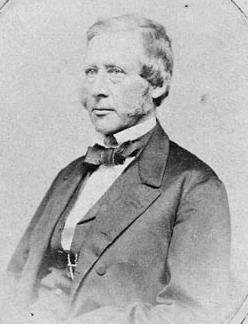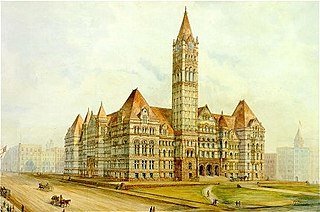John Collins | |
|---|---|
| Died | 1795 Quebec |
| Nationality | British |
| Occupation | Surveyor |
| Known for | negotiated the Toronto Purchase |

John Collins was an influential Deputy Surveyor General in the Province of Canada shortly after it was captured by the British. [1]
John Collins | |
|---|---|
| Died | 1795 Quebec |
| Nationality | British |
| Occupation | Surveyor |
| Known for | negotiated the Toronto Purchase |

John Collins was an influential Deputy Surveyor General in the Province of Canada shortly after it was captured by the British. [1]
According to the Dictionary of Canadian Biography little is known of Collins's early life. [1] Samuel Johannes Holland, Surveyor General when Collins was appointed his deputy, on September 8, 1764, wrote that he had been “imployed for many years as a deputy Surveyor in the Southern Colonys”.
The Dictionary of Canadian Biography notes he was a prominent Freemason. [1] His wife, Margaret, died in 1770, and he had at least one child, a daughter, Mary, who married John Rankin, also a surveyor.
Collins was appointed Deputy Surveyor General on September 8, 1764. [1]
His first major assignment, in 1765 was to survey the border between Canada and the Province of New York. [1]
On September 23, 1787, Collins represented Governor General Lord Dorchester in the negotiation of the Toronto Purchase. [2]
In the Province of Canada the Legislative Council's laws were not fully binding on the Governor, and the Governor appointed many of its members. Collins was first appointed to the Legislative Council in 1773. [1] And was entrusted with positions on multiple administrative committees.

John Graves Simcoe was a British Army general and the first lieutenant governor of Upper Canada from 1791 until 1796 in southern Ontario and the watersheds of Georgian Bay and Lake Superior. He founded York, which is now known as Toronto, and was instrumental in introducing institutions such as courts of law, trial by jury, English common law, and freehold land tenure, and also in the abolition of slavery in Upper Canada.

The Province of Canada was a British colony in British North America from 1841 to 1867. Its formation reflected recommendations made by John Lambton, 1st Earl of Durham, in the Report on the Affairs of British North America following the Rebellions of 1837–1838.

Guy Carleton, 1st Baron Dorchester, known between 1776 and 1786 as Sir Guy Carleton, was a British Army officer, peer and colonial administrator. He twice served as Governor of the Province of Quebec, from 1768 to 1778, concurrently serving as Governor General of British North America in that time, and again from 1785 to 1795. The title Baron Dorchester was created on 21 August 1786.

The Province of Quebec was a colony in British North America which comprised the former French colony of Canada. It was established by the Kingdom of Great Britain in 1763, following the conquest of New France by British forces during the Seven Years' War. As part of the Treaty of Paris, France gave up its claim to the colony; it instead negotiated to keep the small profitable island of Guadeloupe.

Events from the year 1787 in Canada.

Edward Barron Chandler was a New Brunswick politician and lawyer from a United Empire Loyalist family. He was one of the Fathers of Confederation.

Brigadier-General Sir John Johnson, 2nd Baronet was an American-born military officer, magistrate, landowner in the British Indian Department who fought as a Loyalist during the American Revolutionary War. He was the son of Sir William Johnson, 1st Baronet, who was the first British Superintendent of Indian Affairs. He inherited his father's baronetcy and estate in 1774.

Sir David William Smith, 1st Baronet was a soldier and political figure in Upper Canada.

The First Parliament of the Province of Canada was summoned in 1841, following the union of Upper Canada and Lower Canada as the Province of Canada on February 10, 1841. The Parliament continued until dissolution in late 1844.
Thomas Dunn was the Lieutenant-Governor of Lower Canada from 1805 to 1807.

The Toronto Purchase was the sale of lands in the Toronto area from the Mississaugas of New Credit to the British crown. An initial, disputed, agreement was made in 1787, in exchange for various items. The agreement was revisited in 1805, intended to clarify the area purchased. The agreement remained in dispute for over 200 years until 2010, when a settlement for the land was made between the Government of Canada and the Mississaugas for the land and other lands in the area.
Sir John Caldwell was a businessman and politician in Lower Canada and the only son of Henry Caldwell, the receiver-general of Lower Canada from 1794.
William Vondenvelden was a German-born surveyor, printer and political figure in Lower Canada.

The Fourth Legislature of Quebec was the provincial legislature of Quebec, Canada that existed from 1878 to 1881, following the general election of 1878.
George Allsopp was a British-born Canadian businessman and government office holder. He became a merchant in Quebec in the 1760s and a seigneur in 1773. He went heavily into debt to open a gristmill, which in 1788 was the province's largest producer of flour. He also lobbied the Quebec and British government for reforms to the Quebec judicial system and the creation of a legislative assembly. He was also appointed to various government positions, including the province's executive council and as a justice of the peace.
The Council for the Affairs of the Province of Quebec, more commonly called the Legislative Council of Quebec, was an advisory body constituted by section XII of the Quebec Act of 1774. Together with the representative of the Crown, it acted, between 1774 and 1791, as the legislature of the old Province of Quebec.
Lieutenant-Colonel Henry Caldwell was a Canadian army and militia officer, a businessman and a member of the Legislative Council of Lower Canada.

Antoine-Charles Taschereau was a government official, land developer, and political figure in Lower Canada and Canada East, Province of Canada. He represented Beauce in the Legislative Assembly of Lower Canada from 1830 to 1838, sometimes voting with the government and sometimes with the Parti patriote, including voting for the Ninety-Two Resolutions. He opposed the union of Lower Canada and Upper Canada into the Province of Canada. Following the union, he represented Dorchester in the Legislative Assembly of the Province of Canada from 1841 to 1844, as an anti-unionist and member of the French-Canadian Group.
Lt.-Colonel James Johnston, J.P., was one of the earliest and principal Scottish merchants at Quebec following the fall of New France; of the firm Johnston & Purss. He was foreman of the first grand jury of the new British province of Quebec, justice of the peace, and colonel of artillery in the British militia.
John Collins was a merchant when he arrived in the Quebec in 1759. He was appointed as Deputy Surveyor to the Office of Surveyor General of lands by Major Samuel Holland. The Office was created to meet the need for more accurate and detailed geographical information about the territory ceded to Great Britain in 1763.
Collins had also become involved in the political life of the colony. In January 1773 he was sworn in as a member of the Council. In 1775 he became a legislative councillor, a position he held for the duration of the Quebec Act and, under the Constitutional Act of 1791, until his death.
On September 23, 1787, the British Crown (represented by Deputy Surveyor-General John Collins under the auspices of Governor-General Lord Dorchester) agreed to purchase 250,880 acres (101,527.5 hectares) of land from the Mississaugas of The New Credit (represented by three Chiefs) that comprises present day York Region and most of the City of Toronto (with Lake Ontario as the southern border, Etobicoke Creek and Highway 27 as the approximate western boundary, Ashbridge's Bay, Woodbine Avenue, and Highway 404 as the approximate eastern border, and Sideroad 15 and Bloomington Road as the approximate northern boundary).